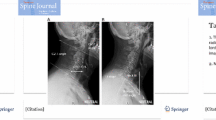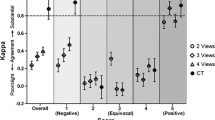Abstract
Purpose
To investigate the feasibility of dual-energy subtraction (DES) in patients with moderate-severe cervical spondylosis for improving delineation of the larynx on flat panel detector (FPD) radiography.
Materials and methods
For 118 patients, we graded conventional/DES anterior–posterior views for delineation of the vocal cords, subglottis, and pyriform sinus using a 5-point scale and lateral views from conventional laryngeal FPD radiography to determine cervical spondylosis severity on a scale from 0 (none) to 3 (severe). We compared the delineation of each anatomical structure in both groups of grades 0–1 and grades 2–3 of spondylosis severity between conventional and DES methods and the improved delineation rate for each anatomical structure by DES compared to the conventional method between both groups.
Results
With DES, the delineation of each anatomical structure was significantly better than with conventional radiography for both groups (P < 0.0001). The improved delineation rate of the vocal cord and subglottis using DES was significantly higher in grades 2–3 than in grades 0–1 (P < 0.05), although there was no significant difference in the delineation rate of the pyriform sinus between the groups (P = 0.847).
Conclusion
DES provides better delineation of the laryngeal anatomy than conventional FPD radiography predominantly in patients with moderate-severe cervical spondylosis.


Similar content being viewed by others
References
Fink C, Hallscheidt PJ, Noeldge G, Kampschulte A, Radeleff B, Hosch WP, et al. Clinical comparative study with a large-area amorphous silicon flat-panel detector: image quality and visibility of anatomic structures on chest radiography. Am J Roentgenol. 2002;178:481–6.
Strotzer M, Gmeinwieser JK, Völk M, Fründ R, Seitz J, Feuerbach S. Detection of simulated chest lesions with normal and reduced radiation dose: comparison of conventional screen-film radiography and a flat-panel X-ray detector based on amorphous silicon. Invest Radiol. 1998;33:98–103.
Bacher K, Smeets P, Bonnarens K, De Hauwere A, Verstraete K, Thierens H. Dose reduction in patients undergoing chest imaging: digital amorphous silicon flat-panel detector radiography versus conventional film-screen radiography and phosphor-based computed radiography. Am J Roentgenol. 2003;181:923–9.
Ricke J, Fischbach F, Freund T, Teichgräber U, Hänninen EL, Röttgen R, et al. Clinical results of CsI-detector-based dual-exposure dual energy in chest radiography. Eur Radiol. 2003;13:2577–82.
McAdams HP, Samei E, Dobbins J 3rd, Tourassi GD, Ravin CE. Recent advances in chest radiography. Radiology. 2006;241:663–83.
Tagashira H, Arakawa K, Yoshimoto M, Mochizuki T, Murase K. Detectability of lung nodules using flat panel detector with dual energy subtraction by two shot method: evaluation by ROC method. Eur J Radiol. 2007;64:279–84.
Machida H, Yoda K, Arai Y, Nishida S, Masukawa A, Asanuma M, et al. Dual-energy subtraction imaging for diagnosing vocal cord paralysis with flat panel detector radiography. Korean J Radiol. 2010;11:320–6.
Resnick D, Kransdorf MJ. Degenerative diseases of the spine. In: Resnick D, Kransdorf MJ, editors. Bone and joint imaging. 3rd ed. Philadelphia: Elsevier Saunders; 2005. p. 394–424.
Sabol JM, Avinash GB, Nicolas F, Claus B, Zhao J, Dobbins JT. The development and characterization of a dual-energy subtraction imaging system for chest radiography based on CsI: Tl amorphous silicon flat-panel technology. Proc SPIE Med Imaging. 2001;4320:399–408.
Yumoto E, Sanuki T, Hyodo M. Three dimensional endoscopic images of vocal fold paralysis by computed tomography. Arch Otolaryngol Head Neck Surg. 1999;125:883–90.
Yumoto E, Oyamada Y, Nakano K, Nakayama Y, Yamashita Y. Three dimensional characteristics of the larynx with immobile vocal fold. Arch Otolaryngol Head Neck Surg. 2004;130:967–74.
Robinson S, Pitkäranta A. Radiology findings in adult patients with vocal fold paralysis. Clin Radiol. 2006;61:863–7.
Conflict of interest
The authors declare that they have no conflict of interest.
Author information
Authors and Affiliations
Corresponding author
About this article
Cite this article
Machida, H., Yoda, K., Arai, Y. et al. Dual-energy subtraction radiography improves laryngeal delineation in patients with moderate to severe cervical spondylosis. Jpn J Radiol 31, 465–470 (2013). https://doi.org/10.1007/s11604-013-0219-3
Received:
Accepted:
Published:
Issue Date:
DOI: https://doi.org/10.1007/s11604-013-0219-3




